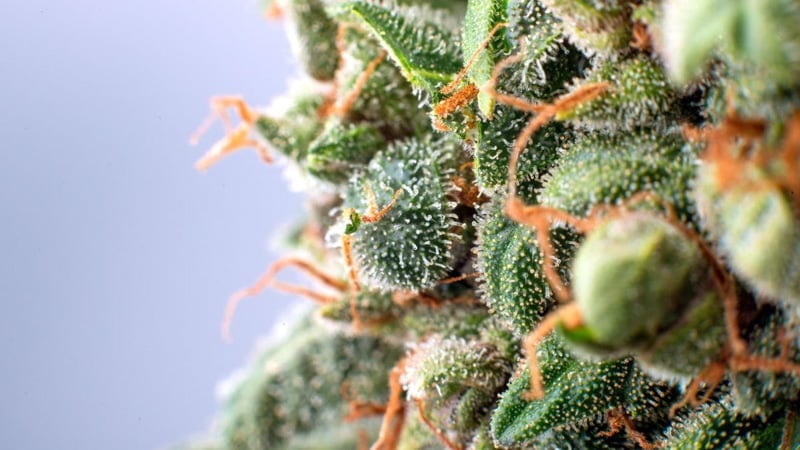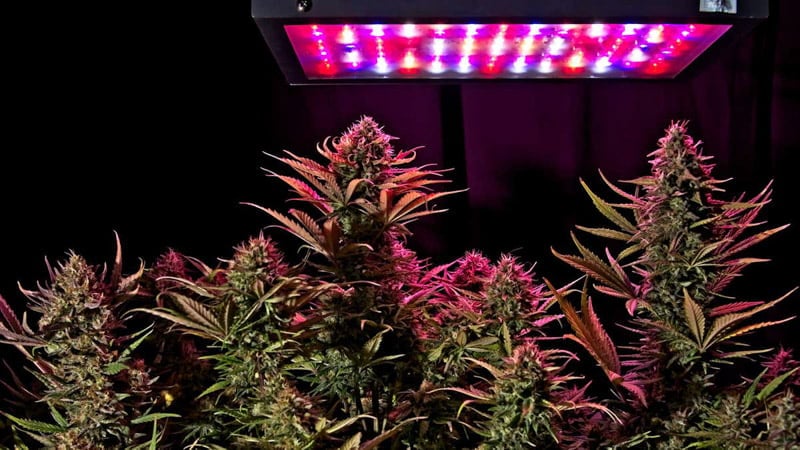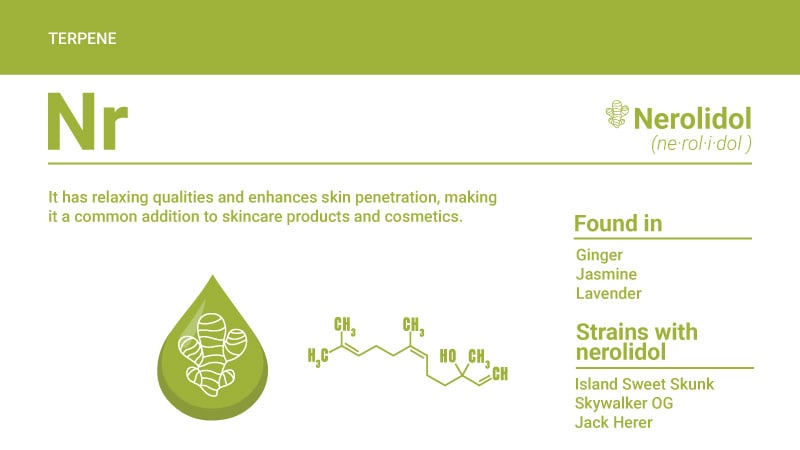Some terpenes are physically noticeable, while others, like nerolidol, fade into the background. Its fresh scent is powerful and enticing, and its effects are gentle — but only on the surface.
It might lull you to sleep as the aroma of apples, rose, and fresh bark invigorates your senses, but much more takes place behind the scenes.
Nerolidol, common in hemp, might be a powerful tool to help you sleep, but there are many other ways you can benefit from it.
What Is Nerolidol?
Nerolidol, also called peruviol and penetrol, is easily absorbed into the skin and even enhances the absorption of other substances.
Because of this, it’s often added to skincare products.
The fragrance or nerolidol makes it a popular addition to perfumes, hair products, and soaps, and it’s considered safe by the FDA as a food flavoring.
And while humans love nerolidol’s scent, pests don’t; it’s used to help fight off lice, spider mites, and even parasites and fungi. In plants, it helps protect them from insects and animals looking to munch on its leaves.
What Does Nerolidol Smell Like?
Nerolidol has a primarily floral fragrance, with hints of apple, citrus, rose, and fresh bark.
The scent of this terpene is truly unique. Every time you take a whiff, it feels like something is different. It’s characteristically citrus, but the floral qualities differentiate it from limonene or valencine (two strong citrus terpenes).
What Are the Effects of Nerolidol?
Nerolidol’s relaxing effects are similar to linalool, potentially making it a good relaxant and sleep aid. Cannabis strains, or other products with this terpene, can be an excellent way to end the day.
The research is still too new to tell for sure, but nerolidol could also play an important role in health.
Plants That Contain Nerolidol
Nerolidol is a dominant terpene in Brassavola nodosa, a Mexican orchid known as “Lady of the Night” because its fragrance is, oddly, only noticeable at night.
Oolong tea is also high in nerolidol and in jasmine, lemongrass, tea tree, lavender, neroli, ginger, ginkgo biloba, and some cannabis strains, all to varying degrees.
It’s considered safe for consumption by the FDA, so you can find it added to many foods, as well.
How Common Is Nerolidol In Cannabis?
Most terpenes are in each strain, even if the amounts are minimal. It’s the unique part of cannabis that makes it so fun.
Some strains are high in limonene, others contain more caryophyllene, and each has different effects.
The following strains contain high levels of nerolidol:
- Island Sweet Skunk
- Jack Herer
- Skywalker OG
- Afghan Moon
- White Fire
- Shiskaberry
- GG4
Nerolidol Research
Until recently, there was very little interest in terpenes. Only a few types of terpenes like myrcene, limonene, and linalool have enough research to warrant any significant claims, and even then, the studies are relatively rare.
Fortunately, the tide has turned, and these intricate compounds are drawing attention because of their seemingly infinite possibilities.
Here’s a look at a few studies that highlight nerolidol’s abilities.
Antiparasitic, Antifungal, & Antibacterial
One study revealed that a high dose of nerolidol reduced the total worm count by 70%.
Though the amount used in this study was incredibly high at 400 mg/kg, nerolidol still proved to be effective in lower doses as well.
Studies show sesquiterpene terpenes like nerolidol can make bacteria more susceptible to antibiotics and antimicrobials. This could be a huge benefit, as some bacteria become more resistant to these medications, making treatment more difficult.
Even fungus might not stand a chance against nerolidol; it seems to have antifungal properties, effectively treating certain fungi without hyperkeratosis and inflammation.
Neuroprotective
Ribonucleic acid (RNA) is similar to DNA but single-stranded. It plays a role in the aging process and is susceptible to oxidative damage. Oxidative stress can damage RNA, resulting in chronic, neurodegenerative, and age-related diseases.
Studies show nerolidol is an antioxidant that may help protect against oxidative damage, making it of particular interest as a possible treatment for neurodegenerative disorders.
Analgesic
Nerolidol might help reduce pain and inflammation, according to some studies.
One study, in particular, found a clear antinociceptive and anti-inflammatory effect from a sample of nerolidol.
Enhanced Skin Absorption
Topical medications are often limited by their ability to penetrate the skin. Some terpenes, especially nerolidol, have excellent permeability and get right past the stratum corneum (the top layer of skin), making them the perfect candidate to sneak other agents through.
Nerolidol is thought to increase drug penetration rates by over twenty times.
Nerolidol Chemical Structure
Nerolidol is a pale, yellow, noncyclic sesquiterpene alkene alcohol. There are actually two kinds, cis-nerolidol and trans-nerolidol, but the term nerolidol refers to both.
As a sesquiterpene, nerolidol is structurally related to other terpenes including beta-caryophyllene, bisabolol, guaiol, humulene, valencene, and more.
Nerolidol Specs:
- Molecular Formula: C15H26O
- Molecular Weight: 222.37
- Solubility: Soluble in most fixed oils and propylene glycol; slightly soluble in water; insoluble in glycerol
- Boiling point: 276°C/528℉
- Safety: Irritant, environmental hazard
Does Nerolidol Get You High?
Terpenes don’t get you high, but they can impact you in other ways, though it’s usually subtle. While they do have physical effects, sometimes the most significant role is in your mood and behavior.
One hypothesis is that aromatic compounds interact with the nervous and endocrine systems, affecting us physically and mentally. It’s also possible that any expectations, emotional associations, and beliefs linked to their use can cause an impact.
More studies show that terpenes and cannabinoids work together, influencing and increasing their effects, so while nerolidol won’t get you high, it might be more effective alongside other terpenes and cannabinoids.
With that said, there are two psychoactive terpenes — myristicin (from nutmeg) and salvinorin A (from salvia).
Related: Do Terpenes Get You High?
Summary: What Makes Nerolidol Special?
We know very little about most terpenes, and many seem to offer similar benefits. Until we have definitive answers, it’s hard to know for sure what specific role each one has.
However, nerolidol’s unique ability to penetrate the skin and its potential to protect against neurodegenerative disorders and affect cancer cells could make it important in future treatments.
References Used
- Russo, E. B. (2011). Taming THC: potential cannabis synergy and phytocannabinoid‐terpenoid entourage effects. British journal of pharmacology, 163(7), 1344-1364.
- Silva, M. P., de Oliveira, R. N., Mengarda, A. C., Roquini, D. B., Allegretti, S. M., Salvadori, M. C., … & de Moraes, J. (2017). Antiparasitic activity of nerolidol in a mouse model of schistosomiasis. International journal of antimicrobial agents, 50(3), 467-472.
- Brehm-Stecher, B. F., & Johnson, E. A. (2003). Sensitization of Staphylococcus aureus and Escherichia coli to antibiotics by the sesquiterpenoids nerolidol, farnesol, bisabolol, and apritone. Antimicrobial agents and chemotherapy, 47(10), 3357-3360. [3]
- Lee, S. J., Han, J. I., Lee, G. S., Park, M. J., Choi, I. G., Na, K. J., & Jeung, E. B. (2007). Antifungal effect of eugenol and nerolidol against Microsporum gypseum in a guinea pig model. Biological and Pharmaceutical Bulletin, 30(1), 184-188.
- Dong, J. R., Chang, W. W., & Chen, S. M. (2021). Nerolidol inhibits proliferation of leiomyoma cells via reactive oxygen species-induced DNA damage and downregulation of the ATM/Akt pathway. Phytochemistry, 191, 112901. [5]
- Ambrož, M., Boušová, I., Skarka, A., Hanušová, V., Králová, V., Matoušková, P., … & Skálová, L. (2015). The influence of sesquiterpenes from Myrica rubra on the antiproliferative and pro-oxidative effects of doxorubicin and its accumulation in cancer cells. Molecules, 20(8), 15343-15358.
- Kong, Q., & Lin, C. L. G. (2010). Oxidative damage to RNA: mechanisms, consequences, and diseases. Cellular and Molecular Life Sciences, 67(11), 1817-1829.
- Dalle-Donne, I., Rossi, R., Colombo, R., Giustarini, D., & Milzani, A. (2006). Biomarkers of oxidative damage in human disease. Clinical chemistry, 52(4), 601-623.
- Vinholes, J., Gonçalves, P., Martel, F., Coimbra, M. A., & Rocha, S. M. (2014). Assessment of the antioxidant and antiproliferative effects of sesquiterpenic compounds in in vitro Caco-2 cell models. Food chemistry, 156, 204-211. [9]
- Fonsêca, D. V., Salgado, P. R., de Carvalho, F. L., Salvadori, M. G. S., Penha, A. R. S., Leite, F. C., … & Almeida, R. N. (2016). Nerolidol exhibits antinociceptive and anti‐inflammatory activity: involvement of the GABA ergic system and proinflammatory cytokines. Fundamental & clinical pharmacology, 30(1), 14-22.
- Cornwell, P. A., & Barry, B. W. (1994). Sesquiterpene components of volatile oils as skin penetration enhancers for the hydrophilic permeant 5-fluorouracil. Journal of pharmacy and pharmacology, 46(4), 261-269.
- Herz, R. S. (2009). Aromatherapy facts and fictions: a scientific analysis of olfactory effects on mood, physiology and behavior. International Journal of Neuroscience, 119(2), 263-290. [12]
- Russo, E. B. (2011). Taming THC: potential cannabis synergy and phytocannabinoid‐terpenoid entourage effects. British journal of pharmacology, 163(7), 1344-1364. [13]


